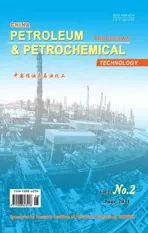Heat Exchanger Network Retrofit of Diesel Hydrotreating Unit Using Pinch Analysis
2021-06-29SunMengyingZhangFengjiaoLiuXinglongSunLanyi
Sun Mengying; Zhang Fengjiao; Liu Xinglong; Sun Lanyi
(State Key Laboratory of Heavy Oil Processing, College of Chemical Engineering,China University of Petroleum (East China), Qingdao 266580)
Abstract: Diesel hydrotreating unit (DHT) is an integral part of the refinery, and its energy-saving optimization is of great significance to the enterprise. In this paper, process simulation software and energy management software are used to simulate the flowsheet and analyze the energy consumption, respectively. Stream data obtained from an existing DHT are applied in the pinch analysis for retrofitting the heat exchanger network (HEN) to achieve maximum energy utilization by using pinch analysis. Since DHT is constrained by pressure, the pressure factor is considered in the process of retrofitting.The results show that the amount of cross-pinch heat transfer is reduced, the inlet temperature of the furnace is increased by 55 ℃, and the amount of hot and cold utilities can be reduced by 70.25% and 50.16%, respectively. The economic evaluation indicates that the operating cost is saved by 4.39×106 $/a, and the payback period is about 2 months.
Key words: pinch analysis; pressure; diesel hydrotreating unit; heat exchanger network; energy saving
1 Introduction
Diesel hydrotreating unit (DHT) is one of the most common units in a refinery and its importance is increasing day by day[1-2]. However, DHT has been characterized by heat leaks, heat losses and inefficiencies in the heat transfer processes[3]. Therefore, the energy consumption analysis and energy saving optimization of this kind of unit can significantly reduce the production cost, which is of great significance to improve the economic benefits of enterprises.
Pinch analysis is one of the optimization methods of heat exchanger network (HEN), which can improve the overall energy utilization of the unit[4-7]. Paiko,et al.[8]used pinch analysis to design the HEN of a naphtha hydrotreating unit. It showed that the method can maximize the recovery of energy and obtain the minimum annual capital cost and annual operating cost.Goodarzvand-Chegini, et al.[9]applied pinch analysis and exergy analysis (the standard to measure the quality of energy) on the hydrocracking process to determine the recoverable energy of the existing unit. As a result, the power generation was 436 kW, and the recovered flue gas lost 5.96 MW, which could also be used to generate 13 649 kg/h of MP steam. Bandyopadhyay, et al.[10]used the pinch analysis to design the HEN of DHT to obtain the minimumTAC, then used the exergy analysis to find out the reasons for the low energy efficiency of the unit and put forward suggestions for improvements. It showed that the energy efficiency of air coolers, fired heaters,and letdown valves can be further improved. Isah, et al.[3]found that a kero hydrotreating unit had great energysaving potential by using pinch analysis, which further showed that retrofitting the current unit was more valuable than redesign. At present, there are few researches on the HEN retrofitting of DHT with pinch analysis. Therefore,we use pinch analysis to carry out systematic and detailed HEN retrofitting of DHT in this paper.
Due to the constraints of high pressure in DHT, the pressure factor should be considered in the process of retrofitting[11]. The main high-pressure streams are the feed stream after feed pump and the reactor effluent[12].Therefore, in the low-pressure side of the feed pump,the heat exchange between the feed and the lowpressure streams should be achieved as far as possible to improve the feed temperature of the pump. However,it is impossible to replace a new pump to increase the feed temperature. For the above reasons, we consider the pressure factor partially in retrofitting HEN of DHT, that is, only consider when matching hot and cold streams,and do not replace the feed pump.
In this paper, pinch analysis is used to determine energy targets, perform energy diagnosis, and explore energysaving opportunities of the present DHT with a capacity of 800 kt/a. The simulation software Aspen HYSYS and the energy management software Aspen Energy Analyzer are combined to retrofit the HEN of DHT. The retrofitted HEN is then compared with the existing HEN in terms of energy consumption and economics.
2 Process Description
The process flow diagram for DHT is shown in Figure 1,which consists of two sections: the reaction section and the separation section.
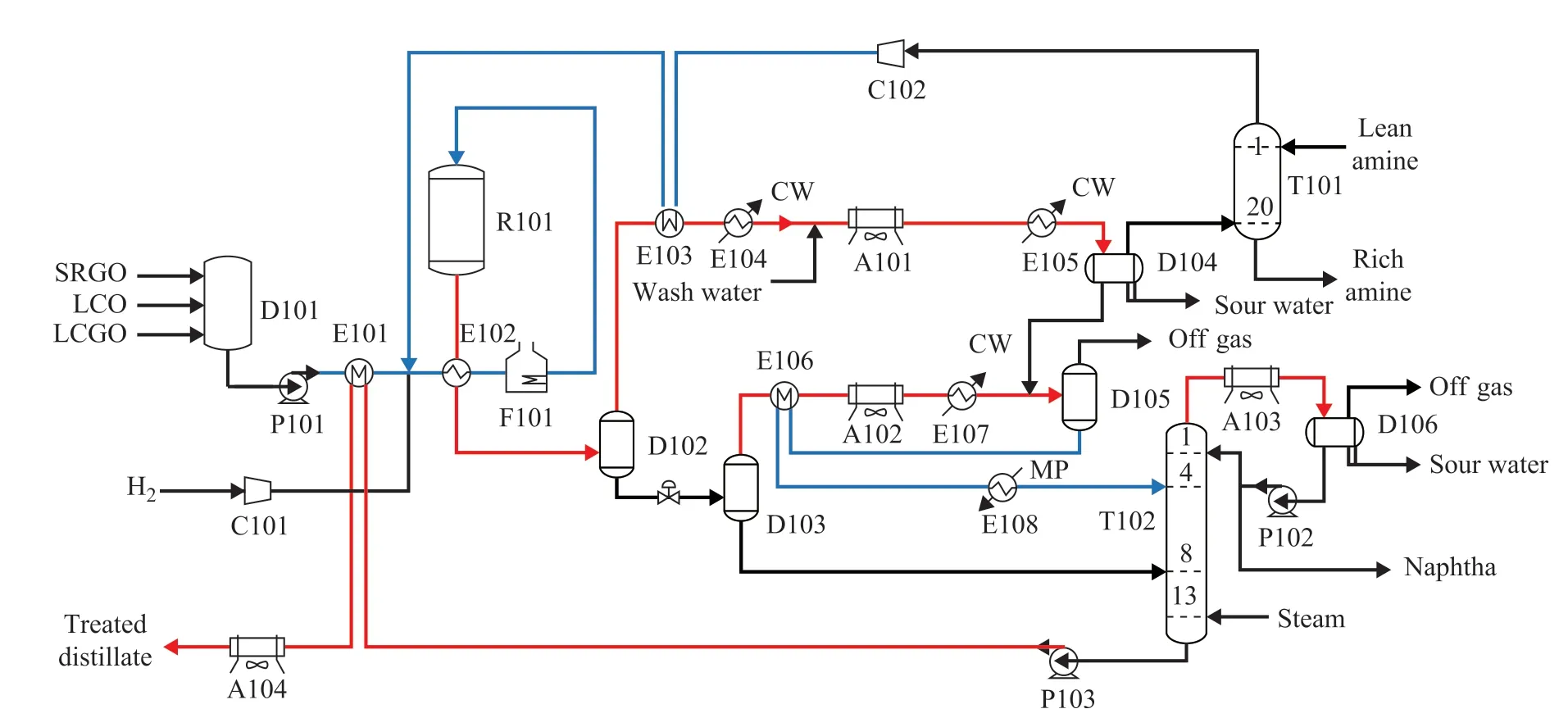
Figure 1 Process flow diagram of DHT
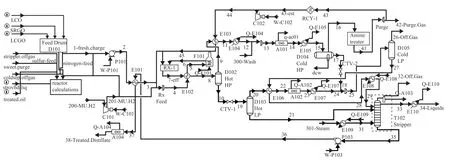
Figure 2 Simulation process of DHT
2.1 Reaction section
The liquid feedstocks include straight run gas oil (SRGO),light cycle oil (LCO), and light gas oil (LCGO), which are mixed in a feed surge drum D101. The combined feed is fed by pump P101 and preheated by exchange with the treated distillate product in exchanger E101. Then it is combined with the make-up and recycle hydrogen streams and heated by exchange with the hot reactor effluent in heat exchanger E102. The combined feed from exchanger E102 is brought to 348.9 ℃ in furnace F101 prior to entry into reactor R101. The reaction product enters the separation section after exchanging heat by E102.
2.2 Separation section
The stream from the reaction section enters the hot highpressure separator drum D102. The vapor from D102 goes to E103, where it is cooled down by exchange with the hydrogen recycle from compressor C102. The high pressure vapor from E103 is further cooled in water cooler E104, air cooler A101, water cooler E105, and then goes into cold high-pressure separator D104 for oil,gas and water three-phase separation. In order to prevent ammonium salt precipitation leading to blocking pipes and equipment, it is necessary to inject water before A101.The vapor from D104 is routed to an amine absorber T101, where the H2S and NH3are removed. Sour water is separated from the bottom of D104 and is recycled.
The liquid from hot high-pressure separator D102 is routed into hot low-pressure separator D103. The liquid from D103 is fed to stripper T102. The vapor from D103 goes to E106, where it is cooled down by exchange with the liquid from cold low-pressure separator D105. The vapor from E106 is further cooled in air cooler A102 and exchanger E107, and sent to D105. The vapor from D105 is sent to a treating plant to remove the H2S prior to use as plant fuel.The liquid from D105 is preheated by the heat exchanger E106 and the heat exchanger E108 serving as a heater and is fed to the stripper T102. The stripping steam is used by T102 to remove the acid gas and other light gases from the liquids, which are in D103 and D105. The overhead liquid product is cooled by air cooler A103 and sent to stripper overhead reflux drum D106 for oil, gas and water threephase separation. The oil phase is divided into two parts,one is returned to T102 as reflux, and the other is removed.The treated distillate product exits from the bottom of stripper T102 and exchanges heat with the fresh distillate feed in exchangers E101 prior to entering air cooler A104.Based on Figure 1, the detailed process system of DHT is established by Aspen HYSYS V9.0[13](a mature process simulation software), as shown in Figure 2. For refinery process simulation, the fluid package is specified to be PR(Peng-Robinson)[14]. The feed properties are shown in Table 1.
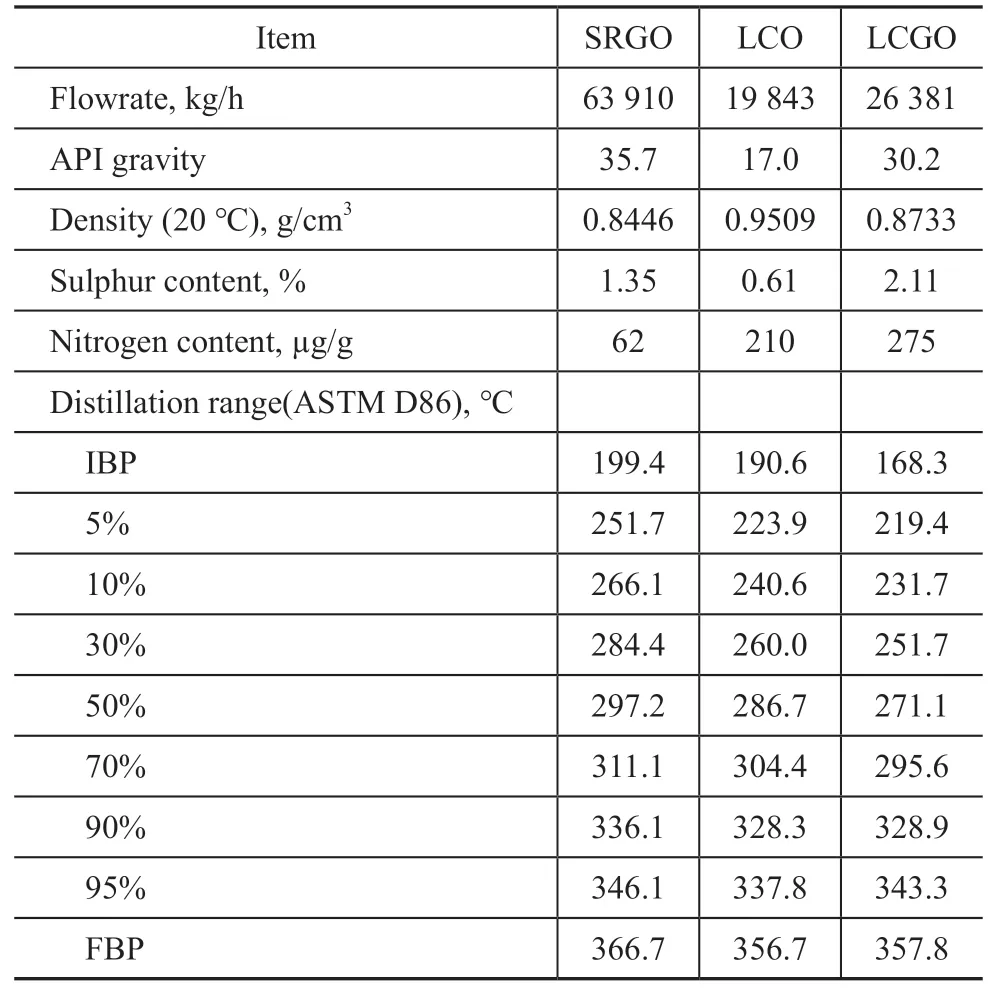
Table 1 Feed properties for DHT
3 Method
There are four key steps in pinch analysis, as shown in Figure 3, including data extraction, process analysis,diagnosis of energy consumption, and HEN retrofit.
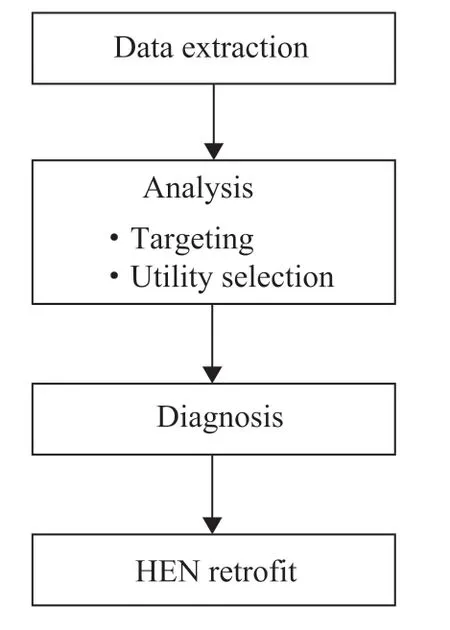
Figure 3 Key steps in pinch analysis
3.1 Data extraction
In this paper, the energy management software Aspen Energy Analyzer V9.0[15]is used to analyze the pinch of HEN. It is necessary to extract flow-sheet data from Aspen HYSYS to Aspen Energy Analyzer, including inlet and outlet temperature, enthalpy value, heat capacity flow rate. One of the advantages of process simulation software is that it can identify the change of heat capacity flow rate, which can make the data more accurate[16-17].The extracted stream data are shown in Table 2, including seven hot streams and four cold streams.
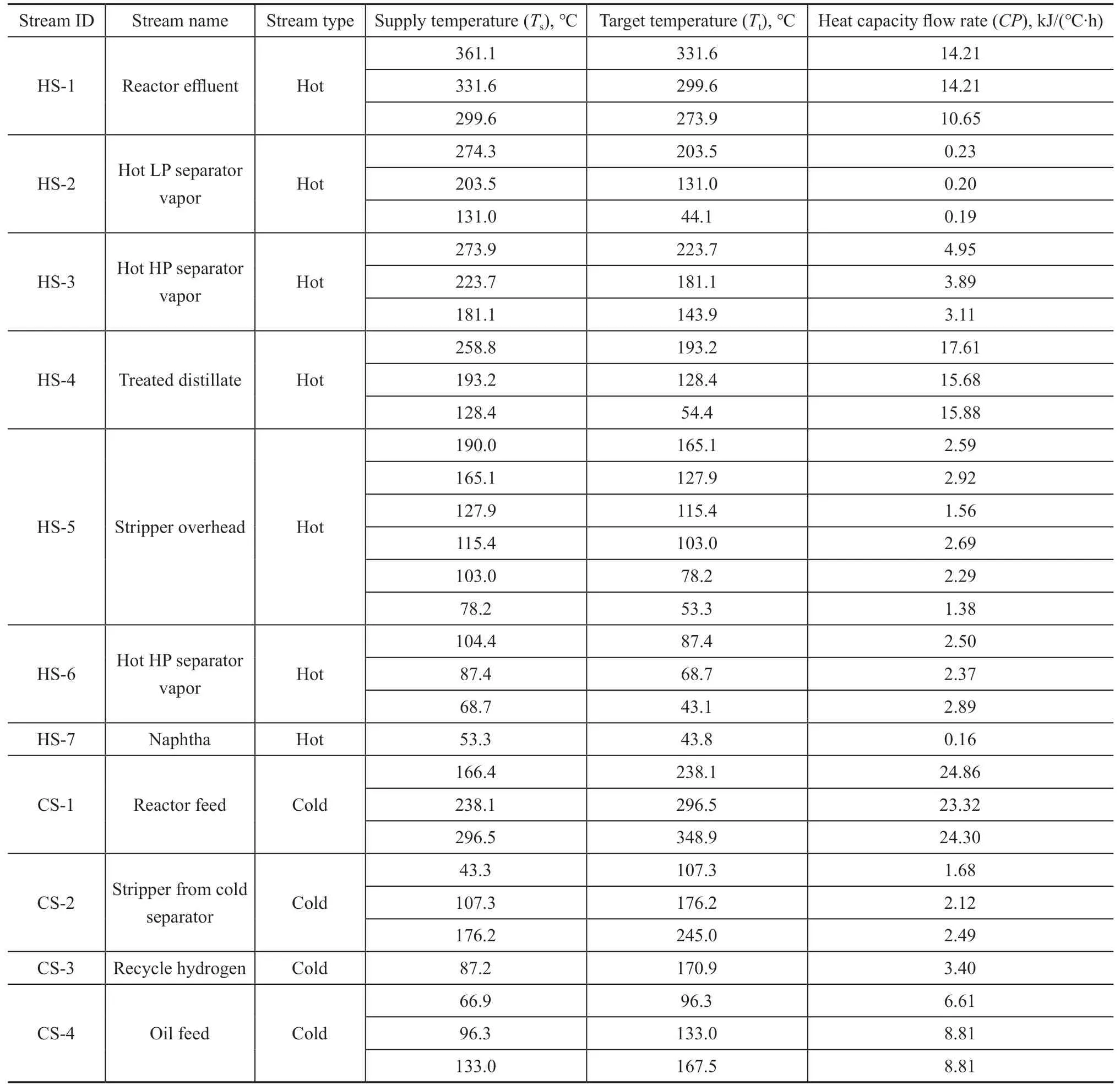
Table 2 The data extracted for the pinch analysis
3.2 Cost data
Total annual cost of the HEN consists of capital costand operating cost[18]. Capital cost is controled by the following elements: number of units, heat exchange area, number of shells and equipment type, etc. The heating and cooling load of utilities constitutes the main part of the operating cost of the HEN. In this work, the capital cost and the operating cost of the HEN are used as the economic evaluation basis for the HEN retrofit.
3.2.1 Capital cost
The capital cost (CC, $) of the network is a single investment required to build the HEN, which is based on the recommendation of Aspen Energy Analyzer and can be calculated by the following equation:

wherea($) represents the installation cost of the heat exchanger;bandcare the duty/area-related cost set coefficients of the heat exchanger;A(m2) is the heat transfer area of the heat exchanger;Nshellrepresents the number of heat exchanger shells in the heat exchanger.
In this work, heat exchanger cost is calculated by the following equation:
3.2.2 Operating cost
The operating cost (OC, $/a) represents the energy cost required for operating the equipment, as shown below:

whereQi,HUandQj,CUare hot and cold utility consumptions,respectively (GJ/h);Ci,HUandCj,CUare utility costs for hot and cold utility, respectively ($/(GJ h-1a)).
The operating time is 8400 h annually, and the utility data of DHT are listed in Table 3.
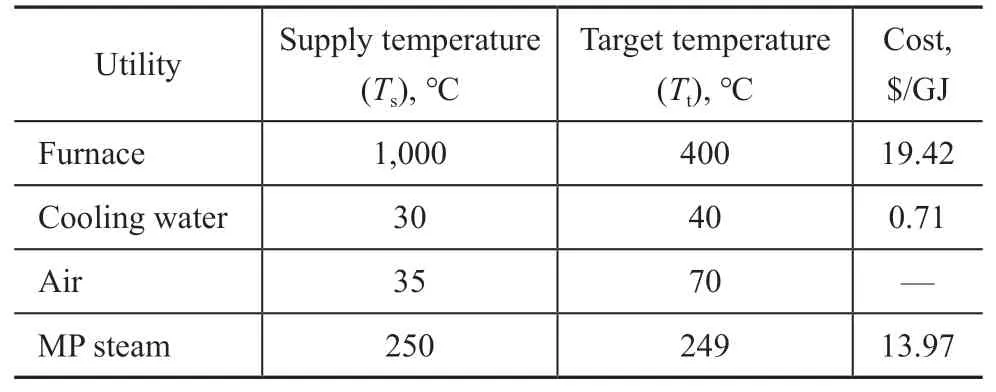
Table 3 The utility data of DHT
3.3 Energy targets
Process streams generally include multi hot and cold streams, which can be expressed in the form of hot and cold composite curves on the temperature−enthalpy diagram(T-Hdiagram)[19]. A cold stream is shown in theT-Hdiagram as presented in Figure 4. The arrow indicates temperature and the direction of enthalpy change, the slope of the line is the reciprocal of the heat capacity flow rate, and the enthalpy change of stream (ΔH) is represented by the distance between two points on the abscissa.
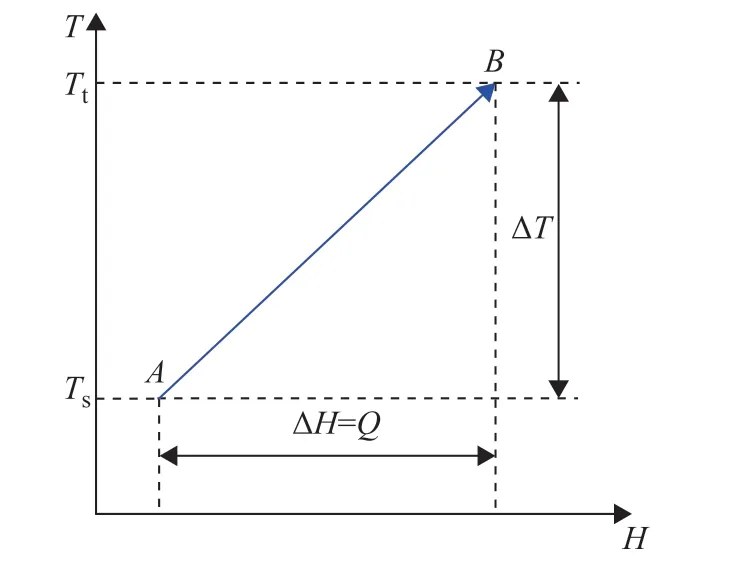
Figure 4 T-H diagram of a cold stream
When hot and cold composite curves coincide in theT-Hdiagram, the overlap point is called pinch. At this point,the amount of heat transfer of hot and cold streams is the largest, and the required amount of hot and cold utilities is the minimum. However, the minimum heat transfer temperature difference is zero, which means that the heat transfer area of hot and cold streams is infinite, that is, it will not happen in practice. Therefore, the pinch temperature difference ΔTmin, the minimum temperature difference of a system, is determined by the technical and economic evaluation. The representation of ΔTminin theT-Hdiagram is shown in Figure 5. At this time,the maximum heat recovery in the process isQR,max, the minimum heat utility consumption isQH,min, and the minimum cold utility consumption isQC,min.

Figure 5 Representation of ΔTmin in T-H diagram
According to the relationship between total cost and ΔTmin,the optimal ΔTminwith the lowest total cost can be determined[20]. The total cost of DHT under different ΔTminis shown in Figure 6. Under the current economic parameters, ΔTminwith the lowest total cost is 7 ℃. The optimum selection of the ΔTminvalue is a result of the trade-off between the operating cost and the capital cost of the network, but the empirical value is often chosen in practice[8,16]. For the present study, ΔTminis identified as 10 ℃.
T−Hdiagram and grand composite curve (GCC) are auxiliary tools in the process of pinch analysis, which can clearly show the pinch temperature and minimum utility usage. As shown in Figure 7,T−Hdiagram and GCC are plotted based on ΔTmin=10 ℃. TheT−Hdiagram and GCC show the pinch temperature is 185 ℃ (corresponding to a pinch at 190 ℃ on the hot streams and 180 ℃ on the cold streams), the minimum hot and cold utility duties are 4.38 GJ/h and 20.16 GJ/h, respectively.
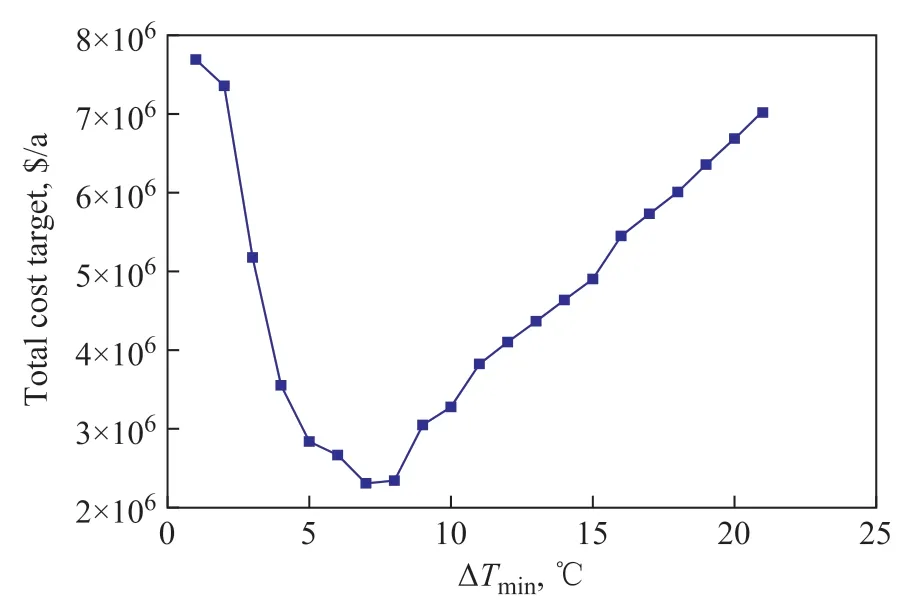
Figure 6 The total cost shows a minimum at the optimal energy consumption
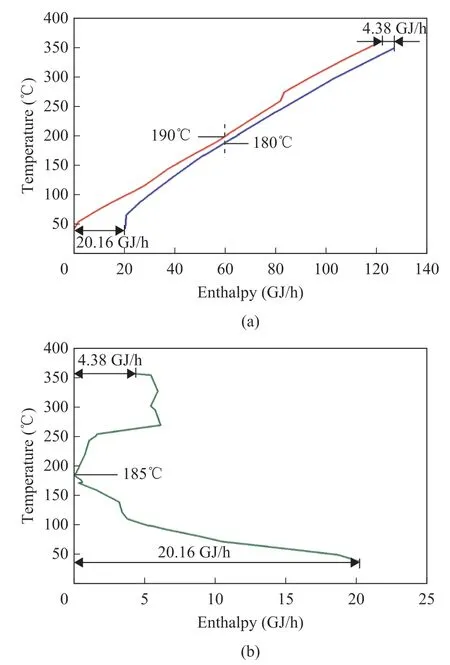
Figure 7 (a) T−H diagram and (b) GCC of DHT
3.4 Energy diagnosis
The hot and cold utilities in existing HEN are 39.40 GJ/h and 55.18 GJ/h, respectively. Compared with the minimum consumption of hot and cold utilities determined in the previous section, there is a potential energy saving of 35.02 GJ/h, accounting for 88.88% and 63.46%, respectively. Therefore, the HEN of DHT has a remarkable potential of energy conservation.
In order to save energy, the better way is to reduce or even eliminate the cross-pinch heat transfer. Based on the grid diagram of the HEN of DHT shown in Figure 8,the heat exchangers of the heat transfer across the pinch can be clearly seen. There are fourteen heat exchangers in the existing DHT, including four heat exchangers in process-to-process streams, one heater, and one cooler.The amount of cross-pinch heat transfer in each heat exchanger is listed in Table 4, with the total amount equating to 35.02 GJ/h. The retrofit sequence of HEN determined by Table 4 is E101, E102, E104, E108, and E103, while the cross-pinch heat transfer of E106 is ignored because its value is too small. In addition, the reasonable utilization of the medium and high temperature heat sources and pressure factor should be considered in the process of retrofitting.
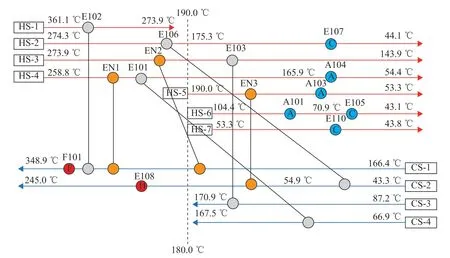
Figure 9 The final optimized HEN of DHT

Table 4 Cross-pinch heat transfer summary
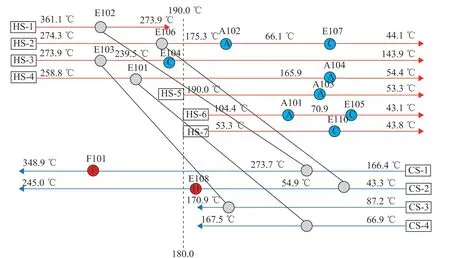
Figure 8 Grid diagram of the current HEN of DHT with pinch line
4 Retrofit of Existing Heat Exchanger Network
4.1 Retrofit scheme
The specific retrofit scheme of DHT is as follows:
• Elimination of heat transfer across pinch in heat exchanger E101.
The heat load of E101 remains unchanged, and the hot end inlet temperature of E101 is modified. Below the pinch, E101 is cooled from 190.0 ℃ to 85.03 ℃.
The heat balance of treated distillate above the pinch is unbalanced, so it is considered to add a new heat exchanger EN1 to exchange heat between the treated distillate and the cold stream. The heat capacity flow rate rule is considered, i.e. the heat capacity flow rate of the cold stream above the pinch is bigger than or equal to that of the hot stream, only the reactor feed can match up to the treated distillate. However, considering the pressure factor, the treated distillate is a low-pressure stream, while the reactor feed is a high-pressure stream. In theory, heat exchange between the two streams should be avoided, but it is limited by the structure of HEN. Therefore, EN1 is still added to achieve heat exchange between the treated distillate and the reactor feed. Treated distillate is cooled from the initial temperature to the hot streams pinch temperature of 190.0 ℃. The amount of cross-pinch heat transfer of heat exchanger E101 and E102 can be eliminated by this step.
• Elimination of heat transfer across pinch in cooler E104.It is necessary to reduce the heat load of E104 to eliminate heat transfer across pinch of E104. A new heat exchanger EN2 is added above the pinch to exchange heat between the hot HP separator vapor and a cold stream. The heat capacity flow rate rule and pressure factor are considered,only reactor feed can match the hot HP separator vapor.
EN2 is added between hot HP separator vapor (upstream of E103) and reactor feed (upstream of EN1). Hot HP separator vapor is cooled from 273.9 ℃ to the hot pinch temperature of 190.0 ℃, and reactor feed is heated from the initial temperature to 189.6 ℃. The amount of cross-pinch heat transfer of E103 and E104 is eliminated by this step.
• Elimination of heat transfer across pinch in heater E108.In order to eliminate the heat transfer of E108 across the pinch, the duty of E108 should be reduced. Steam is used to heat the cold stream above the pinch from 180 ℃ to 245 ℃. The duty of E108 is reduced from 5.979 GJ/h to 2.352 GJ/h.
A new heat exchanger EN3 is added below the pinch to make the stripper from cold separator exchange heat with a hot stream. Considering the heat capacity flow rate rule and pressure factor, EN3 is added between stripper overhead and stripper from cold separator. The low heat oil separator is heated from 54.91 ℃ to 180 ℃,and the stripper overhead gas is cooled from the initial temperature to 151.9 ℃. The amount of cross-pinch heat transfer of E108 is eliminated by this step, and the load of air cooler A103 is reduced by 3.63 GJ/h.
• Evolution.
Hot LP separator vapor is cooled to the target temperature of 44.1 ℃ after passing through heat exchanger E106, air cooler A102, and cooler E107. The heat loads of A102 and E107 are very small, which are 0.26 GJ/h and 0.05 GJ/h,respectively. Therefore, the A102 is deleted, and hot LP separator vapor is cooled from 175.3 ℃ to 44.1℃ by E107.
The heat load of cooler E104 is 0.53 GJ/h, which can be transferred through the path F101-EN2-E104.
Figure 9 presents the final optimized HEN of DHT.
4.2 Retrofit results
The steps of energy-saving retrofit of HEN are shown in Figure 10. By adding three heat exchangers, removing one air cooler and one cooler, the amount of crosspinch heat transfer is greatly reduced, and a better heat integration effect is obtained. Although the added heat exchanger EN2 still transfers heat across pinch, the heat exchangers E102, E103, E104, and E108 no longer have cross-pinch heat transfer, and the amount of cross-pinch heat transfer of E101 is greatly reduced.
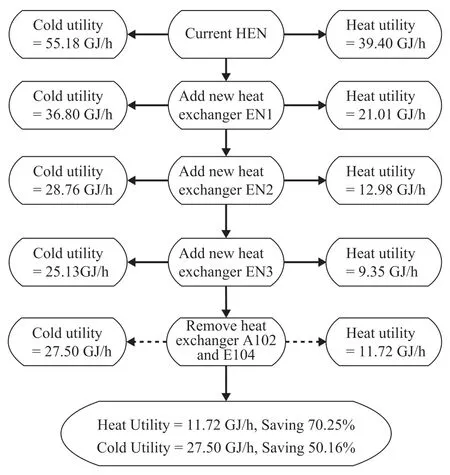
Figure 10 Results of modification for the current HEN
The inlet temperature of furnace F101 increases from 273.7 °C to 328.7 °C, and the heat load of F101 is reduced by 24.05 GJ/h. The retrofit scheme with pinch analysis saves 11.72 GJ/h of hot utility and 27.50 GJ/h of cold utility, accounting for 70.25% and 50.16% of the existing hot and cold utilities, respectively.
4.3 Economic evaluation
Compared with 6.22×106$/a of operating cost of HEN before retrofitting, the operating cost is 1.83×106$/a after retrofitting, which can save 4.39×106$/a. The heat exchangers to be adjusted after retrofitting are presented in Table 5. The heat transfer area of E101,E102, and E103 increases due to the decrease of heat transfer temperature difference. The total capital cost is 5.85×105$, and the payback period is calculated about 2 months.
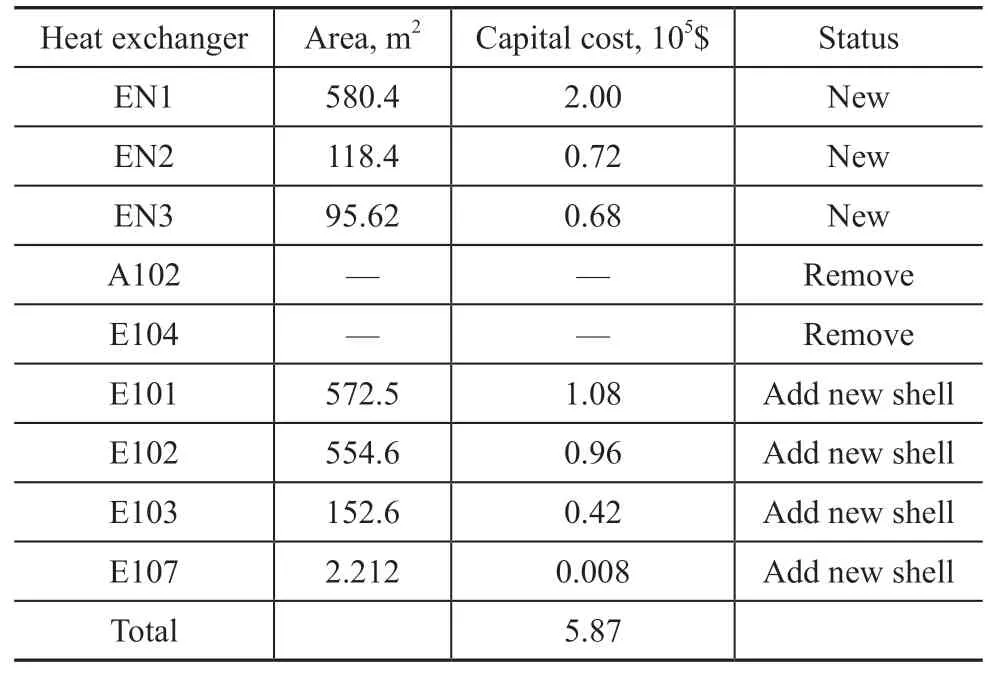
Table 5 Summary of heat exchangers to be adjusted during retrofitting
5 Conclusions
In this paper, the pinch analysis is used to retrofit theHEN of DHT, and the pressure factor is considered. By adding three heat exchangers, removing one air cooler and one cooler, the amount of cross-pinch heat transfer is reduced and a better energy saving effect is obtained.Compared with the existing HEN, the inlet temperature of furnace F101 is increased by 55 ℃, and the consumption of hot and cold utilities are reduced by 70.25% and 50.16%, respectively. It demonstrates that the payback period is about 2 months by economic analysis. Besides,the research on the DHT showed the advantages of pinch analysis in energy saving and the necessity of considering pressure factors in heat exchange network reconstruction for some systems.
Acknowledgments:This work was supported by the National Natural Science Foundation of China (Grant: 21878333).Furthermore, the authors are grateful to the editor and the anonymous reviewers for their helpful comments and constructive suggestions with regard to the revision of the paper.
杂志排行
中国炼油与石油化工的其它文章
- Effect of Acidity on Methylation of Benzene with Methanol Catalyzed by HZSM-5: A DFT Study
- Structural and Textural Transitions of the Zn-BDC Materials During Dehydration-Rehydration Process
- Heat Transfer and Kinetics Study of Moroccan Oil Shale Pyrolysis Process
- Application of a New Catalyst Deactivation Model for Residue Hydrotreating
- High-efficiency Extraction of Bitumen from Oil Sands Using Mixture of Ionic Liquid [Emim][BF4] and Dichloromethane
- Study on Reducing Injection Pressure of Low Permeability Reservoirs Characterized by High Temperature and High Salinity
